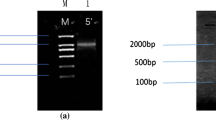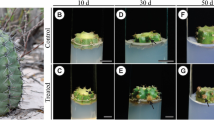Abstract
Morphological changes in early fruit-bearing shoots (FBSs) and in emerging shoot apices of Chinese jujube (Ziziphus jujube Mill. Rhamnaceae) were investigated. Based on histological analysis and morphological observations, FBSs developed from initiated mother bearing shoots (MBSs), while flower development began following growth of FBSs. Moreover, shoot apices were observed at an early stage of floral bud development. A homologue of SQUAMOSA/APETALA1, designated ZjAP1 (accession number EU916199), was isolated from Chinese jujube by reverse transcriptase-polymerase chain reaction and rapid amplification of complementary DNA (cDNA) ends. The ZjAP1 open reading frame was 738 bp in length, including heterogeneous 3′- and 5′-untranslated regions. When aligned with other SQUA/AP1 homologues, the deduced amino acid sequence of ZjAP1 consisted of 245 amino acids with typical SQUA/AP1 MADS-box conserved regions. The ZjAP1 shared highest identity with SQUA/AP1 homologues from Rosaceae. ZjAP1 expression profile was analyzed in early growth of FBSs, shoot apices, and different other tissues. The results demonstrated that ZjAP1 played a role in both vegetative and reproductive development in Chinese jujube.





Similar content being viewed by others
References
Adam H, Jouannic S, Morcillo F et al (2006) MADS-box genes in oil palm (Elaeis guineensis): patterns within the evolution of the SQUAMOSA, DEFICIENS, GLOBOSA, AGAMOUS and SEPALLATA subfamilies. J Mol Evol 62:15–31. doi:10.1007/s00239-005-0333-7
Adam H, Jouannic S, Orieux Y et al (2007) Functional characterization of MADS box genes involved in the determination of oil palm flower structure. J Exp Bot 58:1245–1259. doi:10.1093/jxb/erl263
Altschul SF, Madden TL, Schaffer AA et al (1997) Gapped BLAST and PSI-BLAST: a new generation of protein database search programs. Nucleic Acids Res 25:3389–3402. doi:10.1093/nar/25.17.3389
Fernando D, Zhang S (2006) Constitutive expression of the SAP1 gene from willow (Salix discolor) causes early flowering in Arabidopsis thaliana. Dev Genes Evol 216:19–28. doi:10.1007/s00427-005-0026-7
Huijser P, Klein J, Lonnig W et al (1992) Bracteomania, an inflorescence anomaly, is caused by the loss of function of the MADS-box gene squamosa in Antirrhinum majus. EMBO J 11:1239–1249
Kim S, Koh J, Ma H et al (2005a) Sequence and expression studies of A-, B- and E-class MADS-box homologues in Eupomatia (Eupomatiaceae): support for the bracteate origin of the calyptra. Int J Plant Sci 166:185–198. doi:10.1086/427479
Kim S, Koh J, Yoo MJ et al (2005b) Expression of floral MADS-box genes in basal angiosperms: implications for the evolution of floral regulators. Plant J 43:724–744. doi:10.1111/j.1365-313X.2005.02487.x
Kotoda N, Wada M, Komori S et al (2000) Expression pattern of homologues of floral meristem identity genes LFY and AP1 during flower development in apple. J Am Soc Hortic Sci 125:398–403
Lohmann J, Weigel D (2002) Building beauty: the genetic control of floral patterning. Dev Cell 2:135–142. doi:10.1016/S1534-5807(02)00122-3
Long J, Barton M (2000) Initiation of axillary and floral meristems in Arabidopsis. Dev Biol 218:341–353. doi:10.1006/dbio.1999.9572
Mandel M, Gustafson-Brown C, Savidge B et al (1992) Molecular characterization of the Arabidopsis floral homeotic gene APETALA1. Nature 360:273–277. doi:10.1038/360273a0
Qu Z, Wang Y, Zhou J (1963) A preliminary report on the observation of flower bud differentiation of Chinese jujube (in Chinese). J Hebei Agric Univ 2:7–15
Rodriguez-Concepcion M, Yalovsky S, Gruissem W (1999) Protein prenylation in plants: old friends and new targets. Plant Mol Biol 39:865–870. doi:10.1023/A:1006170020836
Song J, Clemens J, Jameson P (2008) Quantitative expression analysis of the ABC genes in Sophora tetraptera, a woody legume with an unusual sequence of floral organ development. J Exp Bot 59:247–259. doi:10.1093/jxb/erm305
Sun HF, Meng YP, Cui GM et al (2008) Selection of housekee** genes for gene expression studies on the development of fruit bearing shoots in Chinese jujube (Ziziphus jujube Mill.). Mol Biol Rep . doi:10.1007/s11033-008-9433-y
Sung S, Yu G, An G (1999) Characterization of MdMADS2, a member of the SQUAMOSA subfamily of genes in apple. Plant Physiol 120:969–978
Valverde F, Mouradov A, Soppe W et al (2004) Photoreceptor regulation of CONSTANS protein in photoperiodic flowering. Science 303:1003–1006. doi:10.1126/science.1091761
Yao J, Dong Y, Kvarnheden A et al (1999) Seven MADS-box genes in apple are expressed in different parts of the fruit. J Am Soc Hortic Sci 124:8–13
Zhu C (1963) The application of PAS reaction as a stain technique in plant histology (in Chinese). Acta Bot Sin 11:155–166
Acknowledgement
We are thankful to Kotota Nobuhiro for providing degenerate primers in ZjAP1 isolation. The Shanxi Natural Science Foundation committee of China (grant no. 20051081 and no. 20080011062-2) supported this research.
Author information
Authors and Affiliations
Corresponding author
Electronic supplementary material
Below is the link to the electronic supplementary material.
ESM1
(PDF 1574 kb)
Rights and permissions
About this article
Cite this article
Sun, Hf., Meng, Yp., Cao, Qf. et al. Molecular Cloning and Expression Analysis of a SQUA/AP1 Homologue in Chinese Jujube (Ziziphus jujube Mill.). Plant Mol Biol Rep 27, 534–541 (2009). https://doi.org/10.1007/s11105-009-0093-4
Published:
Issue Date:
DOI: https://doi.org/10.1007/s11105-009-0093-4




